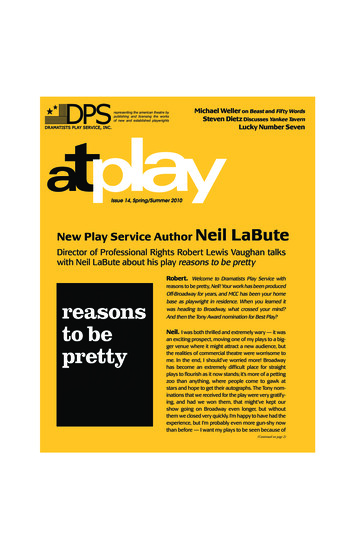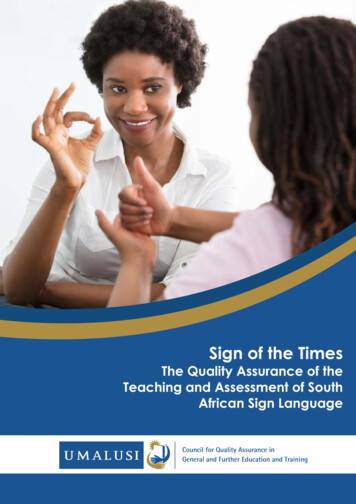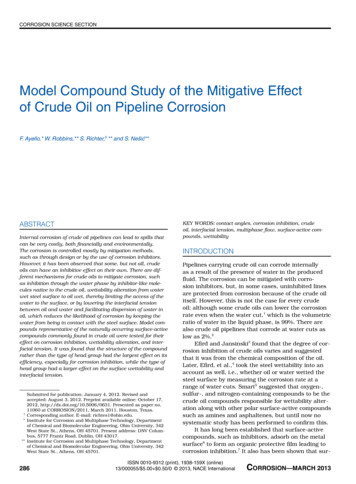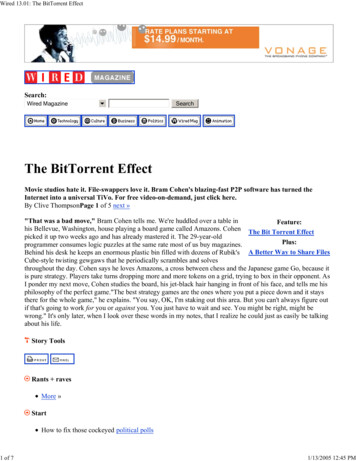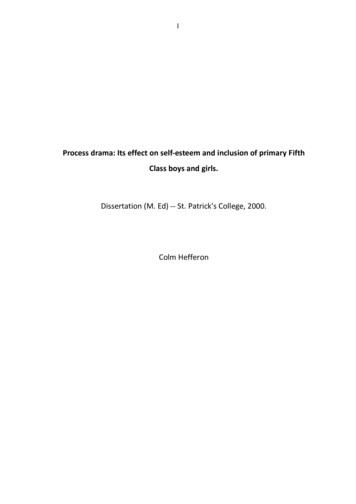
Transcription
1Process drama: Its effect on self‐esteem and inclusion of primary FifthClass boys and girls.Dissertation (M. Ed) ‐‐ St. Patrick's College, 2000.Colm Hefferon
2INTRODUCTION“The self and society are twin born . . . and the notion of a separate and independent ego anillusion.” 1Self and SocietyWhether sleeping in the womb, walking to the shops with his mother or reading withteacher in school, a child is more often in company than alone. His 2 well being and self‐esteem are largely formed in relationship with his primary caregiver. They are the child’sfirst link to society at large. The quality of inclusion in those relationships can be apredictor of the child’s future relationship with society when they grow up.A problem can arise if a child does not belong in a group. This factor is anindication of low self‐esteem. If each member of the group is to negotiate meaningsuccessfully, it is important that each one feels they are safe, belong, and are liked fortheir own self. If a group is not including someone it is both a reminder of, andcontributor to, his low self‐esteem. The theory of the looking‐glass‐self, where I judgemy self‐esteem by what others reflect to me is pertinent here.To make a construction analogy, if the self is the building block, society is thebonding cement that holds all the different selves together, in a mutual dependency.Should the foundations show cracks the edifice will crumble. Both self and society willsuffer in the process. The time and effort put into building an individual’s self‐esteem isrewarded. The prize is a self, integrated with authenticity into the group.This is one of the express affective intentions of the formal education system, tointegrate the self into society. Studies show that children with low self‐esteem are mosthighly represented in statistics of early leavers. 3 A child with high self‐esteem,therefore, will remain longer in school and have more success.1Cooley, C.H. (1912). Human Nature and the Social Order. New York: Scribners, p. 5.In the interests of simplicity the masculine form has been used through out this document to representboth genders.3Kite, H. (1989) How to prevent dropout: Orlando , Florida. This is dealt with later under School dropout.2
3Self‐esteem is vital to a child’s affective and cognitive development. Reasonerdefines the Five Pillars of Self‐esteem as : Security, Identity, Belonging, Purpose andCompetence. 4 Low self–esteem and feelings of exclusion can lead to deviancy andalienation, and are an important indicator of academic and social success. As these areparticular goals of the primary curriculum, they need to be given due attention.Role of Education in Social IntegrationSociety talks to the self through the social discourse of education. In this way the self isinculcated into society. To be an accepted member of the group the self needs to beeducated in the values, attitudes and beliefs of that group.The way in which a group inculcates values and attitudes in order to inform andcontrol behaviour is central to this research. What behaviour is expected will dictate notonly what is taught to the young of a society but, pertinently, how it is taught. Teachingmethods, if inadequate or mishandled, can undermine the learning of even the mostattractive subjects.Progressive Education: the Group and the SelfRousseau’s influence on the progressive educational movement resulted in a model ofeducation that is child centred. The learner actively engages in things that are as close tonatural man as possible. Games, free play and interaction between pupils weredeveloped by Froebel among others. To create a positive environment for thisfundamental unit of society, the individual, would have mutual benefits for both societyand the individual in question. In their child centred epistemology, the self was at thecentre of its own learning.However, what learning was it, and who would benefit? This was learning aboutthe creative self, working on personal issues through play. This learning‐ as‐ process wasdifficult to conceptualise and thus was often placed by successive Departments ofEducation on the edges of the school curriculum. This erroneous practice has beenimproved by the introduction of the new primary curriculum. If a child’s self is affirmedin free‐expression, he will see learning as a process in which he can create and develop.4Reasoner, R. (1994). Building Self‐esteem in the Elementary schools. California: The ConsultingPsychologists Press.
4In Dewey’s process model of learning, the pupil is socially active in his learning,negotiating meaning with the group, forming and affirming his own in the process. Theself as creator and negotiator, acting, as Piaget would say “in and on the world”.However, the learner still needs the guidance of a skilled teacher, a facilitator in thechild’s creativity.Role of the TeacherThe teacher in a state school is an executive of state policy. They are the mediatorsbetween the state and the self.Historically, the quality of that mediation is a reflection of a society’s worldview,from education as product to education as process, from the individual as passiveattender of traditional learning to the individual as creator and negotiator of meaning ina group. Bolton calls this way of learning ‘self‐spectator’, Boal calls it the ‘spectator’ andFreire calls it the ‘spectator as actor. It parallels the Looking‐Glass View of self, whereone sees oneself clearly in the reflection of others. 5 In each the learner is at the centre ofhis own transformation.In this new way of learning, involving the participant as actor, what is the role ofthe teacher? The traditional model is replaced by a more progressive force, leading andmotivating, as influential organiser of the enterprise in hand. The teacher /pupilrelationship, mirroring the mother/child relationship, has a determining influence on thesocial inclusion of the child and particularly his self‐esteem. What then is the bestmethod to raise self‐esteem, in a social context?Role of Drama in EducationDrama in Education can offer a method to make pupils aware of self‐esteem andinclusion as a concept, to define them, and use them. This will occur in the context of theinclusive interaction between the individual and the teacher, the other pupils, and thework in hand, creating the conditions in which the gap between self‐image and ideal self‐image could be narrowed. The forum and opportunity are both ideally created in aProcess drama class.5Cooley, C. H. (1912). Human Nature and the Social Order. New York: Scribners, p. 152.
5As Nicky in St. Rita’s described it, “We were learning, but we were having fun aswell.” I argue that the achievement of that negotiation will lead to an increase ininclusive behaviours and self‐esteem. This project will seek to do this using Drama inEducation as a method, with the purpose of promoting self‐esteem through inclusion.The Process Drama Experiment will focus on Reasoner’s Five Pillars of Self‐esteem,mentioned earlier.
6CHAPTER ONETheoretical Developments Underpinning Self‐EsteemThis chapter is concerned with a review of the literature in relation to the varioustheories of self, from which contemporary formulations derive.SummarySelf‐esteem is determined largely by feedback received from the social environmentincluding home and school. It is important to note that all the beliefs and images whichwe hold as an integral part of our self‐concept were not present at birth. Most of thebeliefs we hold are acquired before adulthood. In early infancy, the formation ofchildren’s self‐concept is influenced to a large extent by non‐verbal communication. Thequality of the relationship with the essential caregiver is crucial to the development of ahealthy self. When this is unavailable to the child on a continuous basis the childwithdraws and is unable to develop satisfactorily, the child will present in school aswithdrawn, insecure and unable to communicate needs. This often results inunacceptable behaviour that is disruptive. Self‐esteem is defined as a combination ofinherent endowments, accomplishments and feelings of lovableness, value, respect andcontrol over one’s life.With intervention of Drama in Education at the school stage, the child, along withthe teacher and the group, should be able to enhance this process and in some casesreverse it.Developments in Self‐Esteem TheoryThe literature suggests that a scientific consideration of the self came to the fore in thelatter part of the nineteenth century when William James 6 promoted it as apsychological issue. James puts forward a view of a global self that comprises fourcomponents, spiritual self, material self, social self, and bodily self. According to James,these four selves combine in unique ways to establish people’s view of themselves thatcannot be easily separated. He saw self‐esteem as the discrepancy between one’s ideal
7self and one’s perceived self. His principle of self‐esteem, known more commonly asJames’ law may be stated as follows:“With no attempt, there can be no failure, with no failure, no humiliation.So our self‐feeling in this world depends entirely on what we backourselves to be and do. It is determined by the ratio of our actualities toour supposed potentialities; a fraction of which our pretensions are thedenominator and the numerator our success.” 7In his time, the pretensions referred to aim, intention, purpose or goal. Therefore,success in attaining one’s goal would produce self‐esteem. This was one of the firstattempts at formulating a definition of self‐esteem and was focused primarily on theindividual’s evaluation of his own adequacy.Symbolic InteractionismSocialisation is frequently referred to and has been cited as perhaps the most importantfactor in the development of the self‐concept. 8 During the early part of this century, thestudy of the self moved into the sociological realm, where Charles Cooley (1864‐1929)and George Mead (1863‐1931) were the major theorists. Both were symbolicinteractionists who produced considerable insights into the relationship between theself and society. Symbolic interactionism proposes that the meaning and evaluation ofsymbols, including symbolic labels applied to oneself, are learned during everydayinteraction with one’s network of social relationships 9 and can be defined as follows:“The symbolic part of the term refers to the assumption that theenvironment should be regarded as consisting of objects whosesignificance lies in their social meaning. We are surrounded by a world ofsymbols, not a world of objects. Interactionism refers to the fact that viasymbols, we are able to communicate with one another and to do thisrequires the ability to regard the world from another’s perspective. Theunit of analysis for symbolic interactionism is not an isolated individual,but the interaction between two people; the self and the other. One of6James, W. (1890). Principles of Psychology. New York: Holt, pp. 310‐312.Ibid.8Dechant, E. V. (1977). Psychology in Teaching Reading. New Jersey: Prentice Hall.9Rose, A. (1962). Systematic Summary of Symbolic Interaction Theory. in Human Behaviour and SocialProcesses: An Interactionist Approach. Boston: Houghton Mifflin.7
8the results of interacting with another and taking the other’s perspectiveis that the self is confronted with itself. It is in this way, thatinteractionists argue we are made aware of ourselves.” 10Initially Cooley believed individuals were independent of society. He later revised histhinking to the point where he proposed in fact “That self and society were twin born and the notion of a separate and independent ego an illusion.” 11 Subsequently, heagreed with Mead that the self arises from social conditions.Direct social comparisons provide the individual with information about himself;for instance, compared to me he can run faster, she is quicker to grasp a point, and theyare more assertive in conversation. But much of the self‐knowledge that one elicits fromothers does not come from direct comparison. It comes from an analysis of feedbackfrom others. Verbal and non‐verbal communications provide a continuous responseabout the impression one is making.It was Cooley who initially identified the importance of feedback from others as aprimary source of information about the self. He believed that the self‐concept isformed as a result of symbolic interaction between the individual and the various groupswith which he interacts. This is referred to in the literature as the Looking Glass Theoryof Self. The looking glass reflects the imagined evaluations of others about one. Cooleyproposed that from early childhood our concepts of self develop from seeing how othersrespond to us. This is particularly true in the presence of someone whom we feel to beof importance. More modern theories are consistent in regarding interactions withthese ‘significant others’ as the primary shaper of children’s developing self‐concept.The major contribution of Mead was his insistence that interaction with otherpeople is essential for the development of the self. “Selves can only exist in definiterelationships with our other selves.” 12 He expanded the view of the self as a product ofsocial interaction. He agreed with Cooley that feedback combined with the individual’sability to imagine things from someone else’s perspective provides the basis for a senseof self. As an individual develops and interacts with society, he develops self‐attitudes10Hampson, S. E. (1982). Sources of Information about the self in Personality Development and Learning,London: Open University Press, p. 188.11Cooley, C.H. (1912). Human Nature and the Social Order. New York: Scribners, p 512Mead, G.H. (1982). Self‐concept Development and Education. London: Holt, Rinchart and Winston, p.164.
9consistent with those expressed by others around him. He values himself as they valuehim; he rejects himself to the extent that they reject him. 13Developmental TheoriesErikson identified a series of eight psychosocial stages which provide a conceptualframework for understanding the self’s development at any given point. 14 The theorypostulates that emotional and social growth evolve through different stages. Each stagehas its own particular tasks which must be negotiated successfully if the child’semotional and mental health is to be maintained. 15The crisis for infancy for example is labelled “trust versus mistrust.” By thisErikson means, during infancy, the child must be able to establish a feeling of trust, ofsecurity with its carers. It is important that the infant comes through the first stagefeeling more secure than insecure. In Erikson’s view, each crisis builds on the previousones. Specifically, the successful resolution of each challenge depends on the healthyresolution of the challenges that have preceded it. An infant who has not successfullyresolved the crisis of trust versus mistrust will have a difficult time with any crisis heencounters through the rest of the life cycle. He may always be hesitant aboutbecoming close with others because deep down inside, he fears others will let himdown.Erikson believes that the successful resolution of the crisis of identity versusidentity diffusion, the fifth stage in Erikson’s theory, depends on how the individual hasresolved the previous crises of childhood. Without a healthy sense of trust, autonomy,initiative and industry, it is difficult to establish a coherent sense of identity. Eriksonbelieves that what takes place during adolescence is intertwined with what has comebefore. This is of importance to this project as the pupils are pre‐adolescent, most of thesample being eleven years old. 16Maslow was particularly interested in the process of self‐actualisation. Hesuggested people couldn’t behave in a self‐actualising way unless basic, lower‐level13Burns, R. (1982). Self‐concept Development and Education. London: Holt, Rinchart and Winston, p.18.A table of these psycho‐social stages is in Appendix I v15Erikson, E. (1968). Identity, Youth and Crisis. New York: Norton.16Ibid.14
10needs are gratified. He presented this in what is known as Maslow’s hierarchy of humanneeds. 17Every individual requires food, warmth and shelter; every person requires a safeand secure environment in the home/classroom/workplace; all rational persons want tobe loved, accepted and feel a sense of belonging. Those who do not, feel a sense ofloneliness and isolation. Individuals need a positive sense of self‐esteem in order to feelgood about themselves. In order to attain the stage of self‐actualisation, people requireopportunities to develop inner talents and potential.An individual cannot possibly expect that their needs would be met all the timeby home/school/work. However, if the needs of each stage are not satisfied by someaspects of a person’s life, the resultant effect is that the person will be unable toprogress to the next level towards self‐fulfilment.A recent Irish National Teachers Organisation (I.N.T.O.) report questions whetherthe needs of children raised in poverty are being met. Research presented in the report‘Poverty and Educational Disadvantage’ indicates that poverty adversely effects bothphysical and mental health. The report states that high levels of anxiety and stress, ill‐health and lower life expectancy, feelings of isolation, lack of control and a sense ofstigma have been shown to be part of the experience of poverty. 18 Recognition of thisarea, described as educationally disadvantaged, strengthens the argument forprogrammes that will address self‐esteem issues.Rogers presented the phenomenological approach to the self, also referred to asthe humanistic approach. It is a perspective which“Attempts to understand man through the impressions of the subjectrather than how his needs, feelings, values, beliefs and unique perceptionof his environment influence him to behave as he does” 19This represents a swing from the socio‐cultural perspective as the major determinant ofself‐development. It proposed that an individual’s behaviour be influenced not only bysociety but also by what he, as a unique individual perceives the situation and his role17For chart of Maslow’s Hierarchy of needs see Appendix I vi.Poverty and Educational Disadvantage. (1994). Dublin: Irish National Teachers Organization.19Burns, R. (1982). Self‐Concept Development and Education. London: Holt, Rinchart and Winston, p. 19.18
11within it to be. Rogers’ approach centres on two theories, (1) that inherent in theindividual is the capacity for self‐ understanding and (2) the positive ability of theindividual to reorganise self‐strengths. The therapist/educator must be able to“experience an empathic understanding of the client’s internal frame of reference andendeavour to communicate this experience.” 20 His theories have obvious implicationsfor self‐esteem initiatives and the role of the educator. It is clear that given the Rogerianconditions, students have the capacity to reorganise their self‐perceptions and acquire amore positive self‐esteem and take a stand with regard to feedback.Studies by, for example, Stern (1985) and Winnicott (1965) have shown that themother‐infant relationship is crucial to the development of the self.Winnicott 21 observed that many adults in therapy had problems that could have beendiagnosed in the infant‐mother relationship. In Winnicott’s terms there was never “justan infant” The mother’s adaptation to the infant’s living needs is essential to thedevelopment of a true self that is a healthy self. 22 According to Stern, the self isdeveloped in relationship and the quality of the essential relationship with the infant’sprimary care giver is crucial to the development of the child to wholeness.Nichols, in his analysis of Stern’s phases of infancy, places listening withunderstanding as the core need during these phases of development. During all thephases, it is necessary that the parent understands the infant and respondsappropriately. The parent needs to respond to the mood of the child. This involvestaking him seriously as an individual. Nichols presents the case of the baby whoseparents tickle and poke him when he is not in the mood, as being as alone as the babywhose parents ignore him. This is the root of aloneness and insecurity. On the otherhand, if a child communicates and does not receive a response they will eventually giveup, and turn inward. 2320Rogers, C. (1977). Carl Rogers on Personal Power. New York: Delacorte Press.Winnicott, D.W. (1965). The Maturational Process and the Facilitating Environment. London: HogarthPress, p.14222Stern, D. (1985) The interpersonal World of the infant. New York: Basic Books, p.1123Nichols, D. (1995). The Lost Art of Listening. New York: Guildford Press, p29.21
12A Definition of Self‐EsteemEarly researchers were not always clear in relation to the terminology. Lawrence 24reported on a study done by English & English in 1958 in which they identified over athousand different combinations and uses of the terms in the self‐concept area, with thesame terms often used to mean different things. Different terms such as self‐esteem,self‐concept and self‐image were often used to mean the same thing.Lawrence presented a clarification of the terminology as he defines self‐esteemwithin the context of self‐concept. He suggests that self‐concept is an umbrella termencompassing self‐image (what the person is) ideal self (what the person would like tobe) and self‐esteem (what the person feels about the discrepancy between what one isand what one would like to become). This can be expressed as eal selfTo understand the term ‘self‐concept’ one needs to ask the question “Who amI?” a number of times. Answers will include such things as: I am John Murphy I am a man I am six foot tall.Additional questions will necessitate the individual giving more information. High self‐esteem levels are revealed in responses such as:24 I am clever I am successfulLawrence, D. (1988). Enhancing Self‐Esteem in the Classroom. London: Paul Chapman, p.xi.
13Ideal self is revealed by responses, which normally include achievement: I would love to play for Ireland I would like to be able to speak in public with confidence.Like Lawrence, more recent observers of self‐esteem place it in the realm ofacknowledging how an individual feels about himself. Adler 25 based his concept of self‐esteem on the individual’s natural striving for superiority, through the achievement ofgoals. He maintained that individuals enter the world in an inferior state and struggletoward superiority. Self‐esteem, to him, was continuously evolving and constitutes thetotality of the perceptions we hold of ourselves at any given moment.In 1992 the board of directors of the National Council for Self‐esteem in theUnited States, which represented twenty four authorities of self‐esteem, agreed on thedefinition of self‐esteem as ‘the experience of being capable of life’s challenges andfeeling worthy of happiness.’ 26 They agreed that it develops from the cognitive processof evaluating oneself and the affective process of feeling one’s worth in five areas:1. Inherited endowments, such as intelligence, appearance and natural abilities,moral virtue or integrity2. Accomplishments or success in life, such as skills, possessions andachievements3. Feeling likeable or loveable4. Feeling unique of value and worthy of respect5. Feeling in control of one’s life.These five elements inform the philosophy, approach and application of this research,carried out with fifth class boys and girls.25Adler, A. (1969). The Science of Living. New York: Double day.Reasoner R (1994). Building Self‐esteem in the Elementary Schools. California: Consulting PsychologistsPress, p 2.26
14CHAPTER TWODevelopment of Drama in Education with Reference to its Application in Self–EsteemEnhancementSummaryThe lineage of Drama as an active learning method will be traced from the beginning ofthis century. This sets the context in which Drama in Education evolved. In this study Iwill review its use as a form of interactive collaboration and the development of modelsof drama from the personal to the social.Connections to theories of socio‐dramatic play will be illustrated. Developmentsin the role of the teacher and views on interventionist play will be described. Techniquesand styles of drama will be examined, from Psychodrama to Drama for free‐expressionand Drama for personal development. More recent developments in Drama in Educationwill be reviewed, particularly teacher‐as‐participant type drama, which changed theeducational purpose and dynamic into a heuristic social voyage in search of meaning. Iwill illustrate the development in Drama in Education of Process drama.Theoretical Origins of Drama in EducationPhilosophy: Learning methodsThe origin of Drama in Education owes much to two educational disciplines: EducationalPhilosophy and Psychology of learning.While O’Neill would say “drama is a mode of learning,” 27 I feel that Freire’steacher‐as‐learner philosophy 28 is equally important in the formation of a theory ofDrama in Education. The former presupposes an effect on the latter. For whether, andimportantly how, one uses the method depends on one’s own educational philosophyand personal experience of formal learning. Both influence one’s own choice of learningmethod, and thus teaching style.27O’Neill C. & Lambert, A. (1982). Drama Structures. London: Hutchinson, p.11Freire, P. (1993). Pedagogy of the Oppressed: New Revised 20th Anniversary edition. New York:Continuum Publishing Company.28
15Freire criticises the educational status quo or what he calls the ‘banking system’as morally unsustainable, and having a self‐ interest in conservatism and resistance tochange. 29 This “banking system suffers from what he calls what he calls ‘necrophily’, or alove of dead things, a cultural inculcation based on the past, a glorious past which is safeand one which will not cause too much questioning of any ruling social élite. Not only isthe past dead, but knowledge about it is transferred by necrophilic teachers, leading toclassroom lessons that are suffering from what he graphically calls ‘narrative sickness’.In contrast, at a Freirean school, the democratic teacher would be interested in‘biophily’ 30 or living things, including humans, using Drama in Education as ‘a method oflearning’ 31 in pursuit of transformation and ‘humanisation’. 32 This philosophy canchange the question in Dorothy Heathcote’s words 33 from a querulous “What happenedthen?” To a more curious and empowering “I wonder what happens now?” The resultwould be an alliance of teacher /student and student /teacher 34 working in whatHeathcote calls “the crucible of learning” 35. Freire’s powerful and persuasive philosophyof teacher a partner, O’Neill’s “drama as a mode of learning” and learning fortransformation are core values in Drama in Education.Psychology: Play, Intervention and Supported LearningPlayHomo ludens 36 is often seen as the opposite of homo faber, 37 but a reading of theliterature would suggest that there can be more faber in ludens than one might first beinclined to think. The self as imaginative agent is at the heart of children’s play.According to Moyles,29Freire, P. (1998). The Paulo Freire Reader. A. M. Araújo Freire (Ed.). New York: Continuum PublishingCompany, p 67.30Ibid.31O’Neill, C. (1995). Drama Worlds. New Hampshire: Heinemann p.5.32Freire, P (1993). The Pedagogy of the Oppressed: New Revised 20th Anniversary edition. New York:Continuum.33Drury, M. (1994). Drama, an essential component of learning and teaching. A paper to Dramalive.Nov.19th 1994.This organization was subsumed into the Association for Drama in Education in Ireland(ADEI) in October 1999.34Freire advocates this as a paradigm for transformation in Pedagogy of the Oppressed.35Quoted in Bolton, G. (1998). Acting in Classroom Drama, a Critical Analysis London: Trentham, p.177.36Man who plays, or playing man37Man who works, or working man
16“Freud saw fantasy as a way to gain access to the psyche. Emphasising thefunction of the child’s instincts in fantasy play he suggested that throughplay, children will show their inner selves”. 38He proposed that acting out roles would help them to assimilate traumatic experiences.Kitson recognises that very few children present such problems, nevertheless, he seesthe value for play in non‐therapeutic settings like schools. 39 Kitson saw a need for adultintervention in children’s play. He found that children began to lose interest in their playactivities after a short time if there was no tension in the activity. 40 This insertion of atension, then, is the marked difference between child’s fantasy play of Freud and Dramain Education. Success of the intervention, according to Neelands, depends on the way inwhich tension is inserted by the teacher, with as he says “ a subtle tongue”. 41Kitson also favours Bruner’s use of a interventionist approach by the supportiveadult which he calls ‘scaffolding’, 42 that with this, the participating adult can “keep theactivity going by motivating the children to persist”, 43 the pupil can “behave andfunction at a cognitive level beyond their norm”. He further states that “the teacher canprovide a model and also bring a myriad of people, problems, challenges and so on, intothe play”. 44 Moyles says “such adult participation . . . allows for the structuring oflearning areas for the children through the selection of themes or stimulus area” 45, verymuch like the drama facilitator. Bolton supports this saying that dramatic play is ametaphor for children’s lives 46and Erikson stresses the importance of life and rehearsalelement of fantasy play. 47 Moyles reviews the contribution of socio‐dramatic play in theself‐confidence, self‐esteem and social development of children in her book. 48Piaget’s views
inclusive behaviours and self‐esteem. This project will seek to do this using Drama in Education as a method, with the purpose of promoting self‐esteem through inclusion. The Process Drama Experiment will focus on Reasoner's Five Pillars of Self‐esteem, mentioned earlier.



